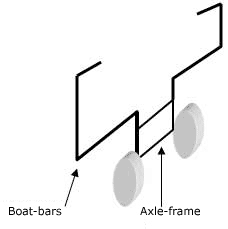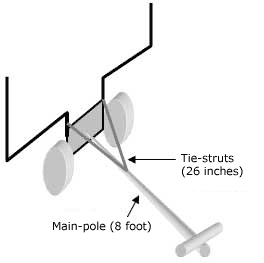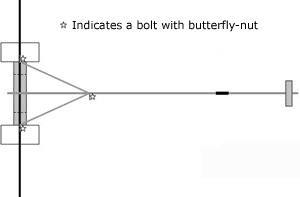and protect your tubes advises R. John Blake
Most boat-tube rips and tears occur whilst moving the boat about on shore without the benefit of a launching trolley. Unfortunately many Tinker-sailors enjoy a love/hate relationship with the now familiar manufacturers trolley illustrated as "Before" in Figure 1.
It is generally agreed that the manufacturers trolley is light, strong, and easily dismantled for packing in the car-boot. Once slid over the boat-tubes this trolley performs well. However, there is no agreement on the best way to get it on the boat prior to launching ... or getting it off again, especially single-handed. The difficulty is compounded by the need to negotiate the boat-bars past the shrouds if the mast is rigged. So we are tempted to drag the boat over short distances ... shish ... POP ****
After dragging my own boat out of the water onto a nail held in the concrete slipway at Chichester last year I resolved to do better, and to this end have now modified my wheels as shown "After" in Figure 2.
The modified trolley remains light, strong, and easily dismantled. There is now one more butterfly nut to apply where the tie-struts meet the main pole. The other end of the tie-struts are held by the butterfly nuts already provided to hold the boat-bars onto the axle-frame.
Overall working diagrams are giving in Figures 3 & 4. Slipping the trolley under a floating boat is made much easier if the main-pole is kept relatively long ... about 8 ft for a Traveller. Recovery is then smooth as the boat glides in through the gate-guides created by retaining the vertical portions of the original boat-bars. The main pole can be reduced to convenient packing length by using a tube-joint.
The success of the modifications depends on achieving a strong attachment of the main-pole to the axle-bar. To this end an inch thick board should be placed on each side of the axle-bar and permanently bolted in place with four nuts & bolts, a "key-hole" having already been cut in the boards to take the end of the main-pole. This hole should be positioned down low just above the axle height to keep a maximum vertical separation between the main-pole and the tie-strut attachment points on the axle-frame.

Figure 1 - Before modification

Figure 2 - After modification

Figure 3 - Looking side-on

Figure 4 - View from above
